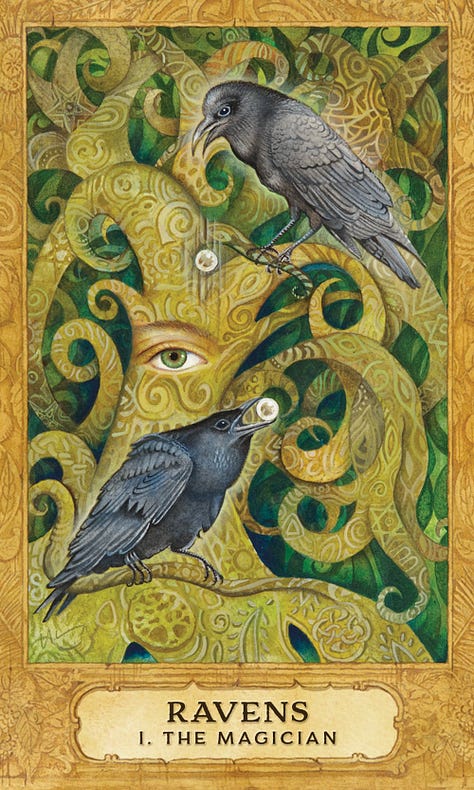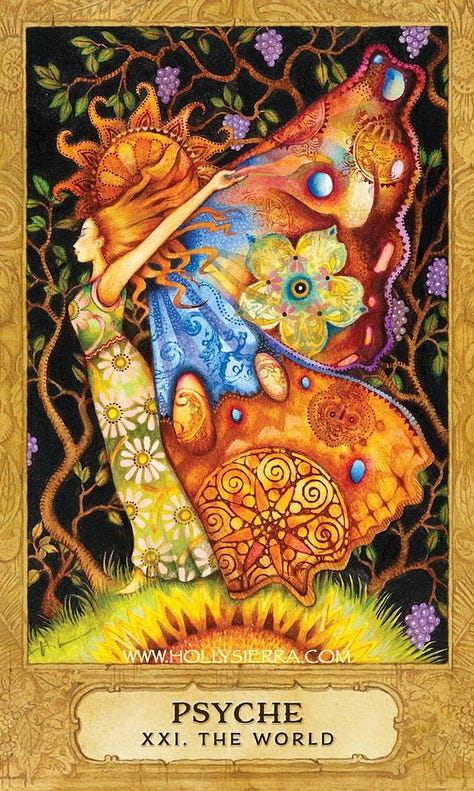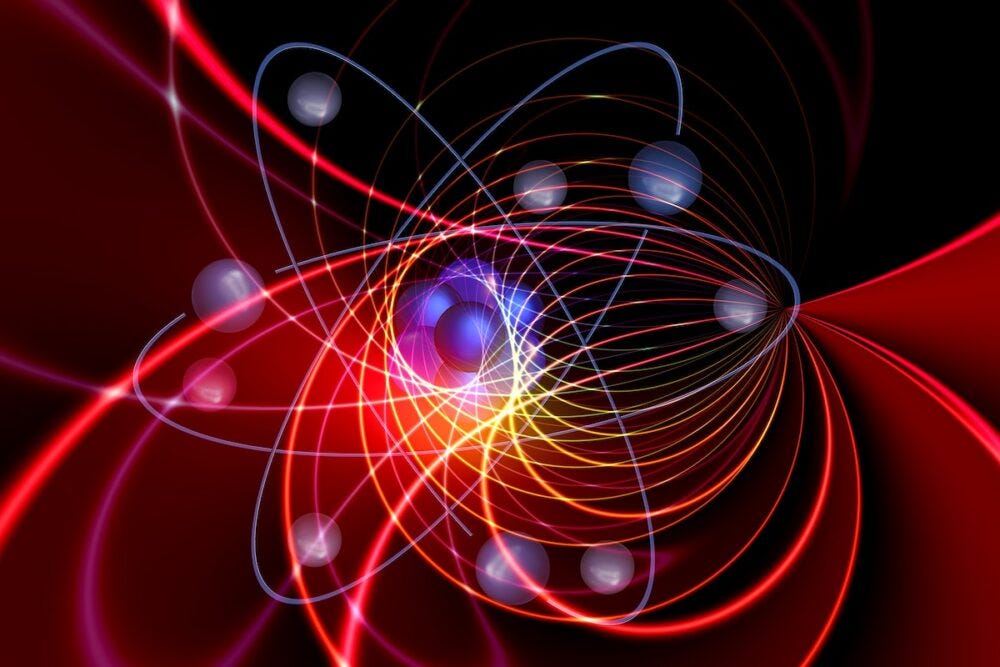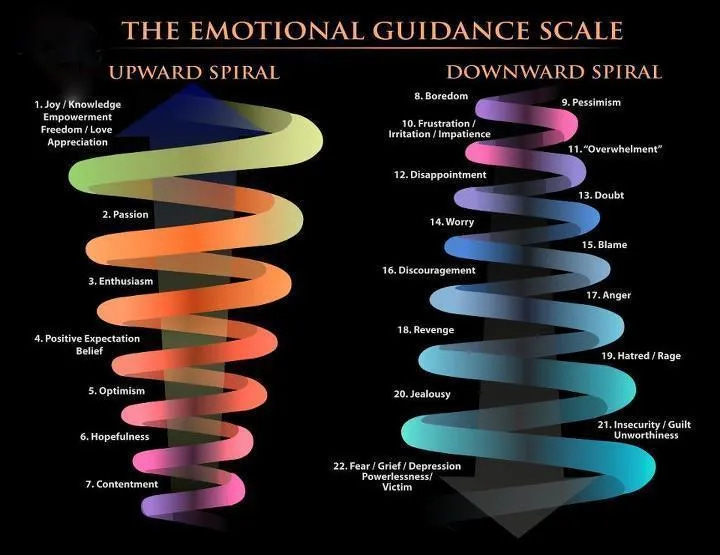In this essay we will offer a compelling vision of the afterlife, drawing on Consciousness Field Theory to propose that personal consciousness survives death and coalesces into an eternal state of resonance that we describe as advanced quantum coherence.
Drawing upon metaphysical propositions and scientific insights from quantum field theory, we discuss the nature of consciousness as a fundamental force, the role of psychions and microtubules in the formation of individual minds, and how this process explains the soul’s entry into Heaven.
Additionally, we contrast Heaven and hell as states of being defined by psychonic frequencies — Heaven as a union with divine consciousness, and hell as a self-imposed separation, determined by one’s choices and spiritual disposition.
We will present an argument in defense of the perpetuation of personal consciousness beyond death. For clarity, we define personal consciousness as synonymous with the psyche, or human soul (with psyche translating to 'soul' in Greek).
Psychions and nonlocal consciousness
For personal consciousness to persist after death, it must, by definition, be nonlocal — inferring it is not merely an emergent property of the brain. Rather, consciousness should be understood as a foundational principle of the cosmic order.
As theologian Paul Tillich noted, “Consciousness is the ground of all being.” Physicist Max Planck, the founder of quantum theory, similarly asserted, “You cannot get behind consciousness.”
As the popular epigram suggests, 'Looking for the origin of consciousness inside the brain is like looking for the announcer inside a radio.' However, like radio signals, personal consciousness has its own distinct frequency — one that is unique to each individual — and serves as an embodied expression of cosmic consciousness.
In fact, we believe that all dynamic and subtle fields throughout the cosmos, for example, the Akashic Field and Gaia, are integrated aspects of the overarching consciousness field (CF). This dynamic web of fields and substrates — of personal consciousnesses and collective consciousness — interconnects all matter, energy, and information in the universe. This phenomenon is called the cosmopsychism, the view that the universe itself is conscious and possesses a mind-like nature.
Our newsletter, Rational Spirituality, offers a reality-based, spiritually-grounded approach to the sciences of quantum field theory, information theory, and Theory of Mind. Rather than negating religious doctrines, we seek to balance them with fresh perspectives. All our field theories — such as archetypes, quantum decoherence, retrocausality, and others — are grounded in these five metaphysical propositions:
Consciousness as a fundamental property of the universe rather than merely an emergent phenomenon of brain activity alone.
Nonlocal storage and access of information/memories. We advanced this argument in our piece titled The Akashic Field and Prana [here].
The interconnectedness of consciousness across time, space, and throughout the universe. We explored this concept in our piece titled Our Magical Universe [here],
The potential for consciousness to influence physical reality at the quantum level. We advanced this argument in our piece titled Retrocausality: 'From All Things One and From One All Things' [here].
The brain as a "transceiver" of consciousness rather than its source. This notion insinuates both a collective consciousness (all humanity) apart from a personal consciousness, (each individual). Moreover, humanity’s collective consciousness includes all archetypes of the collective unconscious (formulated by C.G. Jung), as we maintained [here].
We aim to further articulate our Field Theory of Heaven to a general audience, explaining not only how personal consciousness survives death, but also how the soul’s entry into Heaven is realized. Additionally, we will explore why certain individuals have been assumed — both body and soul — into the hereafter. In conclusion, we will propose a theory of hell defining the underworld as an ‘eternal separation from God.’
A fifth force of nature
In this section, we draw upon the scholarly work of Professor Paul C. Mocombe of West Virginia State University. In 2021, Dr. Mocombe introduced a quantum materialist theory on the origins and nature of consciousness, which he terms 'Consciousness Field Theory.'
His theory posits that consciousness is a fundamental force of nature, akin to gravity and electromagnetism. It suggests the existence of a consciousness field (CF) composed of quantum particles called 'psychions.' These psychions carry information, experiences, and feelings (qualia), which are shared and replicated throughout the universe.
Within the brain, psychions interact with microtubules — tiny structures within neurons — to create the mind. Essentially, consciousness is a cosmic phenomenon that becomes individualized through this interaction.
To understand this theory, it's essential to grasp the concept of qualia —subjective, qualitative properties of our experiences. Qualia represent the 'what it's like' aspect of consciousness. For instance, the redness of a rose, the taste of chocolate, or the sensation of pain are all examples of qualia. According to this theory, qualia are not merely products of the brain; like consciousness itself, they are fundamental components of the universe, carried by psychions woven into the fabric of the consciousness field.
Psychion — The fundamental building block of consciousness, analogous to a subatomic particle like an electron or quark. It exists within the consciousness field, carrying qualia and other forms of information. Essentially, a psychion can be thought of as the raw material of consciousness.
Psychon — The form psychions take when interacting with the physical world, particularly with the microtubules in the brain. A psychon is the embodied, organized form of a population of psychions. In this framework, the raw material of consciousness becomes structured within a living being, giving rise to mind. If a psychion is the 'atom' of consciousness, then a psychon is the 'molecule.'
Microtubules — Microscopic, hollow cylindrical structures within cells, which act as a cellular skeleton and play key roles in intracellular transport and cell division. In neurons, these protein-based structures are particularly abundant and are hypothesized to participate in quantum-level processes that may be linked to consciousness.1
Consciousness Field Theory elucidates the following processes
Psychions exist within the consciousness field — Psychions, or particles of consciousness, carry qualia and information, potentially across the entire universe and even into the multiverse (a hypothetical concept we will explore another time).
Psychions interact with matter — This interaction is theorized to occur in the microtubules of neurons in the brain. It's worth noting that Rational Spirituality subscribes to the theory of panpsychism, which suggests that everything in the universe, from subatomic particles to galaxies, possesses some quality of inner experience or consciousness.
Microtubules as quantum processors — Microtubules, composed of tubulin proteins, function as quantum processors within neurons. Their unique structure allows for quantum coherence, potentially enabling them to process and integrate the information carried by psychions at the quantum level.
This interaction creates a psychon — A psychon is an organized, structured field of consciousness that gives rise to individual mind. The interaction between psychions (particles of consciousness) and cerebral microtubules forms the interface between the consciousness field and an individual’s neural network, facilitating the emergence of a psychon or localized personal consciousness.
Psychons return to the consciousness field after death — Upon the death of the physical body, the psychon, carrying the essence of an individual’s consciousness, returns to the broader consciousness field. In this process, the psychon transcends physical limitations and merges back into the cosmic fabric, resonating at a frequency determined by the soul's spiritual development and psychonic coherence.
This distinction between psychions (particles of consciousness) and psychons is crucial to the theory, as it bridges the perceived divide between the cosmic consciousness field and individual minds. It offers a mechanism for how the raw material of consciousness, carried by psychions, becomes organized into structured, individualized consciousness — a psychon — that we experience as 'you' or 'me.'
This process also suggests how a universal consciousness field could give rise to the vast range of conscious experiences present throughout the universe — from the simplest forms of awareness to complex cognition, potentially including even alien intelligences.

Heaven
When the physical body dies, a psychon carrying the essence of an individual’s consciousness is released. Picture it as a butterfly emerging from its chrysalis, freed from the limitations of its former shell. This psychon returns to the cosmic consciousness field — a boundless realm of pure awareness, thought, and emotion. This transition is not a journey to a physical location but a process of dissolving the boundaries of self, merging with an all-encompassing field of conscious awareness.
Within this cosmic field, a psychon does not simply cease to exist; it persists, experiencing a timeless existence where past, present, and future merge into an eternal now. The qualia carried by the psychion — those subjective experiences of love, joy, and beauty — are no longer filtered through the limitations of the physical body and brain. Instead, they are amplified and intensified, becoming a source of unending bliss and profound understanding.
This ascension process is not exclusive to a select few from any single tradition. It is the eternal destiny of all who attain a specific psychonic frequency, as we shall see. Throughout history, individuals from various cultures and spiritual paths have reached an elevated form of this state of being and conscious awareness while on Earth, a process known as theosis.2
We see this phenomenon reflected in the enlightened figures of Buddhism, such as Gautama Buddha, who attained Nirvana and transcended the cycle of rebirth, and in the bodhisattva Quan Yin, as well as Krishna in the Hindu tradition.
We also find this phenomenon in the mystical traditions of Judaism, with figures like Melchizedek, the enigmatic king and priest. In the Bible, Melchizedek is portrayed as a figure who represents or prefigures Jesus Christ, and some assert that he is a Christophany of Jesus. This perspective offers a fascinating glimpse into the possible rebirth of highly evolved souls.
Then Melchizedek king of Salem [which means ‘peace’] brought out bread and wine; he was priest of God Most High. And he blessed [Abraham], saying, 'Blessed be Abram by God Most High, Creator of heaven and earth. And blessed be God Most High, who delivered your enemies into your hand.'
Genesis 14:18-20
Also — “You are a priest forever, in the order of Melchizedek.” (Psalm 110:4)
The Christian tradition, particularly Protestant denominations, emphasizes St. Paul of Tarsus, whose transformative encounter on the road to Damascus made him a pivotal figure in early Christianity. He is also associated with the Ascended Master Hilarion. Many believe that Western Christianity is predominantly Pauline, while Orthodoxy remains closer to the original Christianity of the Jerusalem Church.3
Esoteric traditions point to powerful beings like the Archangel Metatron, who is also identified as Thoth, the scribe of the gods in Egyptian mythology, and as Enoch, who, according to biblical accounts, “walked with God” and was taken up to heaven without experiencing death.
In certain traditions, Hermes Trismegistus is viewed as an amalgam of Metatron, Thoth, and Enoch, further enriching his symbolic significance. He was the legendary 'thrice-blessed' sage and alchemist, embodying the concept of ascended mastery and spiritual enlightenment. He is also credited with authoring the Emerald Tablet, which contains the famous maxim, "As above, so below."4
These Ascended Masters, having attained a connection to the consciousness field, retain a degree of autonomy and volition that enables them to interact with the physical world, even after the death of their physical bodies.
They may manifest as inner locutions or apparitions, offering guidance and inspiration. In some instances, they may even achieve a type of 're-embodiment,' drawing upon their exalted psychon within the consciousness field to temporarily manifest in physical form.
This phenomenon could explain the appearances of figures like Moses and Elijah at the Transfiguration, the resurrection of Jesus, and even the many apparitions of Mary. In Knock, Ireland, Mary appeared alongside St. Joseph and St. John.5 At Medjugorje, the six visionaries have claimed they are able to physically touch Mary.
The existence of Ascended Masters highlights the limitless potential of consciousness and the remarkable possibility of transcending the limitations of physical existence.
In Islam, Muhammad’s 'Night Journey' and ascension into Heaven is described as a miraculous event in which he traveled from Makkah to Masjid Al-Aqsa in Jerusalem (The Temple Mount) before ascending to heaven — all in one night. In Arabic, Isra' refers to the night journey from Makkah to Masjid Al-Aqsa, while Mi'raj refers to the ascension from Masjid Al-Aqsa to the heavens. Muhammad then returned to complete his divinely inspired mission.
In essence, Consciousness Field theory proposes that Heaven is not a physical place but rather a state of being within the cosmic consciousness field. Our individual psychons, or souls, freed from the constraints of the physical body, return to this realm of pure consciousness, experiencing eternal bliss and unity with the divine. This narrative presents a compelling, scientifically grounded vision of the afterlife that aligns with many traditional notions of Heaven.
Rational Spirituality’s theory of hell
This model also presents a unique perspective on hell as a state of being. Rejecting the traditional view of hell as a fiery realm of eternal punishment governed by a judgmental deity, this theory proposes that hell is a state of separation — a self-imposed exile from the divine consciousness field. Hell is not a place but a state of being characterized by an ultralow psychonic frequency.
The 'Seven Deadly Sins'— pride, greed, lust, envy, gluttony, wrath, and sloth—are not sins in the traditional sense but rather dispositions, tendencies toward ultralow-frequency emotions and behaviors — a type of psychosis. These dispositions generate a dense and heavy psychonic frequency that inhibits a psychon's ability to merge with the consciousness field. Consequently, the soul becomes 'eternally separated from God'— a common definition of hell.
Conversely, high-frequency emotions such as love, compassion, joy, peace, gratitude, and forgiveness elevate the psychonic frequency, serving as a soul's 'ticket to Heaven.' We use the terms psychon, psyche, and soul interchangeably, as they all refer to the potential transcendent and divine quality of a human being.
True 'evil,' in the context of hell, is not merely the cultivation of these ultralow frequency emotions but the embodiment and embrace of a persistent pattern of harmful behaviors. This unfortunate state of being is exemplified by the 'Dark Triad' archetype, characterized by narcissism, psychopathy, and Machiavellianism, and is further elaborated by the Persistent Predatory Personality (PPP) model.6
Such individuals exhibit a persistent pattern of predatory behaviors —manipulation, exploitation, deceit, and total disregard for others — that engenders an ultralow psychonic frequency, a state characterized by disharmony and separation from the source of creation.
This state effectively prevents these souls from successfully merging with the consciousness field at death. During life, they were characterized by an exceptionally low level of self-awareness, which obscured their ability to recognize and subsequently change harmful patterns of behavior and predispositions that might have lead them to rebuke their disabling beliefs.
Spiritual alchemy, traditionally focused on the transformation of the self from base instincts to elevated states of consciousness, often encounters challenges when addressing the more pernicious elements of human character. The Dark Triad and PPP models identify and categorize these elements, presenting a framework that highlights the predatory behaviors that impede spiritual and moral maturity, and lead to an eternal state of separation from God and Heaven.
Ultimately, this theory suggests that neither Heaven nor hell are destinations determined by divine judgment but rather consequences of an individual's choices and psychonic frequency. It emphasizes the importance of fostering high-frequency emotions and overcoming the darker aspects of human nature to achieve true spiritual liberation and union with the cosmic consciousness field.
Why we capitalize Heaven but not hell
Capitalizing 'Heaven' while keeping 'hell' lowercase highlights the contrast between the two.
Heaven signifies a state of ultimate connection, a conscious merging with the divine consciousness field. It is the destination we strive for, the culmination of spiritual growth and self-transcendence. Capitalizing the word underscores its significance and the elevated state it represents.
Conversely, hell represents the absence of that connection—an eternal state of separation and isolation. It is not a fixed place, but a condition of being lost in darkness through its own limited consciousness. Keeping it lowercase reflects this lack of definition and the diminished state it symbolizes.
This linguistic distinction reinforces the idea that Heaven is an achievable goal through human agency, while hell is the consequence of failing to achieve that goal, wittingly or unwittingly. It's not about divine judgment, but simply the natural consequence of our personal choices and the quality of our psychonic frequency.
By capitalizing Heaven and using lowercase hell, we symbolically represent the ultimate choice we face: to strive for connection and unity or to remain encaged in the isolation of our own ego. This choice reflects the difference between actively choosing connection and passively succumbing to or rejecting separation.
Coherent Heaven vs. decoherent hell
Let’s briefly revisit a concept introduced in the opening paragraph — advanced quantum coherence and its relationship to Heaven and hell. Using light as an analogy, a laser represents coherent light, while an ordinary room light bulb produces incoherent light. Laser beams are highly focused and coherent, whereas light bulbs scatter decoherent light in all directions.
Accordingly, Heaven is a psychonic environment characterized by advanced quantum coherence and high resonant frequencies, while hell is an ultralow-frequency environment comprised of decohered and fragmented psychons.
By further describing Heaven as a quantum-coherent state and hell as a decoherent-classical state, we can draw distinctions that mirror the behavior of quantum systems versus classical systems:
Coherence vs. Decoherence — In Heaven, the soul’s psychon is in perfect coherence, maintaining a state of eternal unity with the divine consciousness field. In hell, the soul is in a state of decoherence, unable to resonate with higher frequencies, thus experiencing eternal separation.
Quantum vs. Classical — Heaven represents the quantum realm, where superposition, entanglement, and coherence allow for higher consciousness and interconnection. Hell, on the other hand, represents the classical realm, where the loss of coherence leads to fragmentation and disconnection, limiting the soul to a more mundane, ego-driven existence.
High vs. Low Frequencies — High-frequency emotions resonate in Heaven’s coherent environment, amplifying states of joy, love, and unity. In contrast, ultralow-frequency emotions resonate in hell’s decoherent state, exacerbating separation, isolation, and suffering.
In this expanded framework, Heaven is not merely a state of bliss but a quantum reality, where the coherence of consciousness allows for infinite possibilities and unity with the divine. Conversely, hell is a classical reality, marked by fragmentation and the absence of coherence, where the soul is trapped in a state of eternal separation due to low-frequency resonance and loss of alignment with the divine.
In our exploration of consciousness and interconnectedness, it is important to acknowledge the role of archetypes — dynamic, universal patterns of energy and meaning that reside within the collective unconscious, an integrated aspect of the cosmic consciousness field. Archetypes can offer insights into our psyches, spiritual and emotional well-being, and realities in the world around us, particularly as we navigate the paradigm shift of the Kali Yuga in our current era.
Tools such as Chrysalis Tarot, a unique deck I designed to encourage psychic communication with archetypes, can be invaluable for enhancing self-awareness and intuition. This process of 'active imagination,' as Jung phrased it, ultimately aids our journey toward spiritual liberation, an elevated psychonic frequency, and heightened awareness of the consciousness field of the unseen world.
Three of Chrysalis’ archetypes are featured below. From left to right, The Ravens, generators of synchronicity; Maat, the Egyptian goddess of justice, truth, and order, and Psyche, symbolic of the shift in consciousness known as ‘metanoia,’ a transformative change in one's spiritual ethos.



Chrysalis is available from Amazon and most metaphysical booksellers — You can browse Holly’s Etsy shop here.
A recent proposal by the University of California Los Angeles neuroscientist N. J. Woolf goes so far as to identify the site of memory storage in the locus of microtubule channels: Most contemporary models of consciousness posit synaptic activity as the primary basis of consciousness. The view we propose is that the site of memory storage is not within the synapse, but in the sub-synaptic zone, in the microtubules of the dendrite shaft . . . the logic to this proposal is that the synapse is a channel transmitting information, much like a radio receiver . . . . In this analogy, the receiving channel is the synapse or spine.
Theosis describes the process of becoming like God or participating in the divine nature (deification). It is understood as a transformative journey of grace, initiated through faith and cultivated through prayer, mediation, and acts of loving kindness, all of which raise an individual’s psychonic frequency. Theosis emphasizes the dynamic relationship between God and humanity, wherein believers are called to continually grow in likeness to God, ultimately attaining union.
While this statement is a simplification, it highlights a key difference in emphasis between Western Christianity and Orthodoxy. Western Christianity has been significantly shaped by Paul's writings, while Orthodoxy places more emphasis on the traditions and practices of the early Church, particularly the Jerusalem Church. Western Christianity, particularly Protestantism, heavily emphasizes the writings of Paul. His letters elaborate on concepts like salvation through faith, original sin, and the substitutionary atonement of Christ.On the other hand, the concept of theosis (becoming like God) is central to Orthodox theology. This idea has roots in the early Church and the theological Gospel of John, which speaks of believers sharing in the divine nature. Orthodoxy also places strong emphasis on the traditions and practices of the early Church, as established in Jerusalem.
The Emerald Tablet (article and art)
The Story of Knock (article)
Dark Triad Archetype (Rational Spirituality article);
The ‘Persistent Predatory Personality’ (PPP) model is a theoretical framework in psychology that describes a pattern of behavior where an individual repeatedly engages in predatory actions, often targeting vulnerable individuals, with a consistent and enduring personality style characterized by manipulation, exploitation, and a lack of empathy. PPPs demonstrate a persistent tendency to prey on others across different situations and relationships over time.
Also see (just published):







I like this theory
If I am not mistaken, it was Roger Penrose who first hypothesized distinct quanta of consciousness moving through microtubules which, at the physical level, burgeon off axons; after physical death, these quanta are released into the Greater Field where they coalesce into undying remnants of what we would call "the self". Such a view would substantiate the investigations of Raymond Moody and the University of Heaven. In Robert Monroe's last book, "Ultimate Journey", he described the non-monadic cluster nature of the core self that pertains beyond physical existence, which is a remarkable epiphany. It seems as though the psychion and psychon concepts are really variations on the original notion of the classical photon and Popp's biophoton. The more pressing question right now however, in the context of the WEF, Agenda 2030, and the transhumanism takeover, relates to invasive technologies which generate "false memories", boasted about at Davos 2024. If this is now a given, and if memory in a physical human is predicated upon information passing within microtubules, then what kind of invasive technology would succeed in hacking this? Another important question relates to the linguistic objectification of feeling states as "qualia" distinct from "quanta". This has always been a stumbling block in quantum theory(ies) since the emotional realm is not reducible to quantifiable information and physicists in particular are hardly renowned for their emotional health and emotional self-awareness. The idea of a qualitative fundamental reality as opposed to a quantitative one has been theorized by Ibrahim Karim, founder of Biogeometry, whose spiritual and intellectual roots lie equally in ancient Egypt and esoteric Islam.